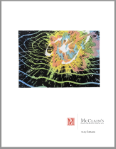
Counterclockwise, from upper left: Speedball 6" Rubber Brayer, Gamsol Mineral Spirits, Japanese 210mm (8 1/4") Hard Rubber Brayer, Japanese 30mm (1 1/8") Soft Rubber Brayer, Japanese 165mm (6 1/2") Soft Rubber Brayer, Takach 1" and 1/4" Specialty Brayers, Takach 12" Hand Brayer. The Brayer used to roll out the Caligo Rubine Red ink is a Japanese 100mm (3 13/16") Soft Rubber Brayer.
Choosing Brayers
Brayers are used by western-style relief printmakers to apply ink to blocks or plates.
(Japanese-style wood block printmakers use brushes for this job.) The size and stiffness of brayer
you choose depends on the kind of printmaking you are doing and the size of the prints you make.
In order to ink up quickly and efficiently, the brayer should be slightly larger than the printing area on the block. You can get by with a smaller brayer, but it takes more time to cover the area and there is more chance of leaving behind marks from the brayer's edges.
Also, the bigger the diameter, the longer the strip of ink the brayer will put down without a lap mark. So you will not have to pick up ink from the slab as frequently with a bigger diameter brayer.
If you make one-color prints, a few brayers in different widths will do. But if you make multi-color prints, then having a variety of brayers is very helpful.
Hard or Soft?
The rubber on brayers come in different hardnesses, called Shore values. The higher the value, the
harder the rubber. Speedball brayers, for example, come in 35 (softer) and 70 (harder) values.
Harder brayers are less likely to dip into cleared areas on the block and it is easier to get the grain pattern in a wood block to show up with a hard brayer. However it can be difficult to get even coverage across the whole block, especially if the block is uneven.
Softer brayers are more popular with most relief printmakers because they are more flexible so it is easier to cover the whole block evenly and quickly. Fine lines are easier to fill in with a softer brayer, so build up thin coats of ink with these brayers instead of applying one thick one.
Roller Materials
Before the development of synthetic rubbers, gelatine was a favorite material for brayers. Gelatine
brayers spread ink easily and were soft and flexible. However, the gelatine would melt if it came
into contact with turpentine, heat or water and they would quickly lose their shape if they were
left laying on a table.
Today, Nitrile rubber, a synthetic material that is tough and durable, is most often used to make the roller. As an added bonus, nitrile rubber does not deform or flatten out with normal use.
However, nitrile is sensitive to UV light. If left in sun light or under florescent lights for a long time, the roller will dry out and crack or split. For that reason, it is a good idea to store your brayers in a box, cupboard or drawer where they are not exposed to light.
High heat can also dry nitrile. Do not store near heating vents. If you live in a hot climate and your studio is not air-conditioned, consider storing your brayers in an air conditioned location.
Cleaning Nitrile Brayers
Clean nitrile rollers as you would your own skin.
First, roll as much ink as possible off onto newsprint. Nitrile can be nicked so do not try to clean off dried ink or bits of wood picked up from the block with a sharp object. Instead, carefully pick the debris off with blunt tweezers or your fingers.
If you are using water- or soy-based ink, rub a degreasing soap like Dawn dishwashing liquid into the rubber. A nail brush is very handy for loosening ink. Rinse well in warm water and dry thoroughly.
If you are using oil-based ink, use a small amount of odorless mineral spirits, like Gamsol, on a rag to clean the remaining ink from the brayer. Some people like to use vegetable oil to clean brayers but it can leave behind a film that will contaminate the ink the next time the brayer is used. If you clean your brayers with vegetable oil, wash them with Dawn dishwashing liquid to remove any remaining oil.
Pay special attention to the ends of the roller, since ink likes to build up there. Wipe any ink off the metal frame and handle. Take your time and make sure the roller is completely clean before you put it away. Clean brayers stay flexible, work better and last much longer.
Store them away from heat or sunlight so they will not dry out. If the roller develops a glaze or becomes hard, the rubber can be reground or replaced.
With care, your brayers will give you good service for many years.

